BUDDHIST WORSHIP
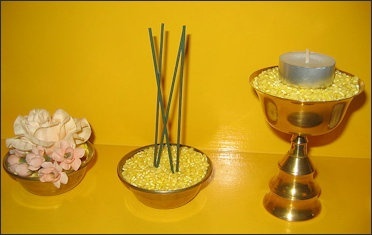
basic shrine offerings: flowers, candles and incense
Buddhists worship at temples, stupas (dome-shaped shrine), Buddhist centers, or in their own homes at small shrines. They may worship in a group or on their own. Om mani padme hum is a mantra, or chant, prevalent in Buddhism, meaning "Hail the jewel in the lotus." It refers to the symbology surrounding the Buddha's miraculous birth. [Source: Encyclopedia.com]
Buddhist worship typically involves veneration, or the showing of respect and admiration towards images of the Buddha, other buddhas, and bodhisattvas. For Theravada Buddhists, the Buddha is the primary object of veneration, but for Mahayana and Tibetan Buddhists, a number of buddhas and bodhisattvas are venerated. Veneration is demonstrated with offering of flowers, burning incense,, water in beautiful bowls and fruits to statues or painting of The Buddha or bodhisattvas or a relic of a buddha and an important Buddhist figure. Important monks also often become objects of devotion. In Japan, for example, the bodies of particularly famous monks are embalmed and sometimes encased in shellac and then put on display as a kind of present master.
It is not considered essential to go to a temple and worship with others. At home, Buddhists often set aside a room or a part of a room as a shrine that includes a statue of Buddha, candles, and an incense burner. Some Buddhists place Buddhist texts or Buddhist symbols, such as prayer beads or a bell representing the enlightened mind, on their shrine. Buddhists pray to the Buddha or other Buddhas depending on the tradition. They usually bow before the image of the Buddha or Buddhas as they worship. Buddhists also make offerings of food, incense, and water at their home shrines, just as they would at a temple. By making such offerings and by engaging in meditation and generosity, Buddhists build up merit (See Below). This merit, Buddhists believe, helps determine the life the Buddhist they experience at rebirth and brings them closer to enlightenment.
Websites and Resources on Buddhism: Buddha Net buddhanet.net/e-learning/basic-guide ; Internet Sacred Texts Archive sacred-texts.com/bud/index ; Introduction to Buddhism webspace.ship.edu/cgboer/buddhaintro ; Early Buddhist texts, translations, and parallels, SuttaCentral suttacentral.net ; East Asian Buddhist Studies: A Reference Guide, UCLA web.archive.org ; View on Buddhism viewonbuddhism.org ; Tricycle: The Buddhist Review tricycle.org ; BBC - Religion: Buddhism bbc.co.uk/religion
RECOMMENDED BOOKS:
“Everyday Buddhism: Real-Life Buddhist Teachings & Practices For Real Change”
by Wendy Haylett Amazon.com ;
“Pearl of Wisdom (Buddhist Prayers and Practices) by Thubten Chodron Amazon.com ;
“The Essentials of Buddhist Meditation” by Shramana Zhiyi, Bhikshu Dharmamitra Amazon.com ;
“Guided Buddhist Meditations: Essential “Practices on the Stages of the Path” by Thubten Chodron and Dalai Lama Amazon.com ;
“Samsara, Nirvana, and Buddha Nature” by His Holiness the Dalai Lama and Thubten Chodron Amazon.com ;
“Buddhist Scriptures” by Donald Lopez (Penguin Classics) Amazon.com ;
“What the Buddha Taught” by Walpola Rahula Amazon.com ;
“In the Buddha's Words: Anthology of Discourses from the Pali Canon” with Bhikkhu Bodhi, the Dalai Lama Amazon.com ;
“The Heart of the Buddha's Teaching” by Thich Nhat Hanh Amazon.com ;
“Mindfulness in Plain English Paperback” by Bhante Bhante Gunaratana (Author) Amazon.com ;
“The Heart of the Buddha's Teaching” by Thich Nhat Hanh Amazon.com ;
“The Heart Sutra: A Comprehensive Guide to the Classic of Mahayana Buddhism”
by Kazuaki Tanahashi Amazon.com ;
“The Lotus Sutra: A Contemporary Translation of a Buddhist Classic”
by Gene Reeves Amazon.com ;
“The Dhammapada” (Easwaran's Classics of Indian Spirituality) Amazon.com
Puja and the Worship of Buddhist Images
Images of the Buddha are the most common objects of devotion. They are viewed as objects of contemplation, admiration and imitation and as vehicles by which one can cultivate the Buddha's auspicious qualities, Some believe they possess physical power and, like relics, are said to embody something of the presence of the Buddha himself (especially in the Mahayana and Tibetan Buddhism). [Source: Jacob Kinnard, Worldmark Encyclopedia of Religious Practices, 2018, Encyclopedia.com]
Puja is important in Buddhism and Hinduism. Jacob Kinnard wrote in the Worldmark Encyclopedia of Religious Practices: Puja, or "honor," is a ubiquitous form of worship throughout the Buddhist world, most typically directed at images of the Buddha and the various bodhisattvas and at the Buddha's relics. Although the Buddha himself explicitly stated that he was not to be worshiped, either while he was alive or after his death — and that it was the dharma that should, instead, be learned and practiced — puja, in fact, often looks very much like worship, sometimes involving a great outpouring of emotion and adoration, even amounting to what seems like worship of a god. Buddhists frequently make offerings to images, typically fruit but sometimes money, as a gesture of respect, as an act of renunciation, or, in some cases, in the hopes of some favor in return, perhaps happiness or prosperity. Such acts of devotion are often performed in temples but can also be performed in small shrines in the home. [Source: Jacob Kinnard, Worldmark Encyclopedia of Religious Practices, 2018, Encyclopedia.com]
Puja typically involves not only the making of an offering but also meditation and prayer. Frequently a Buddhist layperson will approach an image, make his or her offering, and then kneel in prayer or meditation. These meditations sometimes involve a mental reconstruction of the Buddha's auspicious qualities — perhaps his compassion or his profound wisdom — with the hope of cultivating those qualities oneself. The meditation might be directed to the well-being of others, one's family members in particular, or one's ancestors. These are often individual acts of quiet and contemplative devotion, but in some settings they can also be congregational as well.
Buddhist Rituals
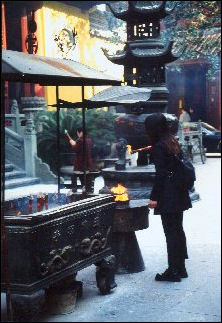
Lighting incense sticks Originally the idea of Buddhism was to achieve enlightenment without the use of gods, priests or other intermediaries. As Buddhism spread and absorbed other religions it became more ritualized. The Buddha rejected the Hindu sacrificial system. Followers were advised to “work out your own salvation with diligence.” Rather than sacrificing animals followers were encouraged to do good deed and services.
According to the BBC: “The Buddhist tradition has developed many different customs and practices in different parts of the world. This may take the form of meditating on the qualities of Buddha, and honouring the Buddha or Buddha-figure. A person could honour the Buddha by making offerings to relics or images of the Buddha. In the Theravada tradition, Buddhist laypersons often give gifts to Buddhist monks but giving is also encouraged more generally, to one another and to good causes. In Theravada Buddhism, monks are considered to embody the fruits of Buddhist practice. Monks' responsibility is to share these with lay Buddhists through their example and teaching. Giving to monks is also thought to benefit lay people and to win them merit. Increasingly, laypeople are becoming involved in meditation, traditionally exclusive domain of monks. In Thailand, Myanmar and Sri Lanka, meditation classes for lay people are held at monasteries and temples. [Source: BBC |::|]
“There are as many forms of Buddhist worship as there are schools of Buddhism - and there are many of those. Worship in Mahayana tradition takes the form of devotion to Buddha and to Bodhisattvas. Worshippers may sit on the floor barefoot facing an image of Buddha and chanting. They will listen to monks chanting from religious texts, perhaps accompanied by instruments, and take part in prayers.” In Tibet, Buddhists l frequently circumambulate a stupa, turning smaller prayer wheels as they do (symbolically turning the Wheel of the Dharma), a ritual act that is sometimes accompanied by making a series of prostrations.
Earning Merit in Buddhism
One of the main goals of Buddhist followers is to earn merit — Buddhist brownie points which help a Buddhist ascend to higher reincarnation levels and eventually reach the state of enlightenment and Nirvana. Earning merit is essentially the same thing as earning good karma and has been described as a “spiritual bank account” in which “doing bad things are withdrawals; making merit is a deposit.”
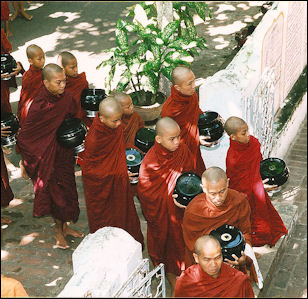
Begging monks in Myanmar Merit is earned by showing devotion to the Three Jewels — Buddha, “Dharma” (Buddha's teachings), “Sangha” (the brother hood of monks) — and doing things like helping out monks, praying at temples, freeing caged birds, tying prayer flags, repeating chants, turning prayer wheels, making offerings and lighting candles, butter lamps and incense burners filled with sandalwood and cypress leaves. Some Buddhists go to markets and buy fish or poultry just so they can set them free.
All good deeds earn an individual some merit. But some acts earn much more merit than others. Acts that are considered particularly meritorious include writing and chanting sutras; visiting special pilgrimage sites; raising temples; offering food and shelter to monks; producing sons that becomes a monks.
The more prayers one says the more merit they earn. Buddhist prayer beads are used to count of prayers in dominations of special numbers. Each time the beads are touched, a prayer is said and merit is earned. Praying 108 times is regarded as particularly meritorious because it “disturbs passions” of “mankind’s delusions” cited in Buddhist scripture.
Acts and Rewards of Devotion to the Buddha
'Shikshasamuccaya,' 299-301 on Acts and Rewards of Devotion to the Buddha in the 'Avalokana-sutra' goes:
Verily, for countless aeons he is not reborn blind or lame,
If, after he has decided to win enlightenment, he venerates a stupa of the Teacher.
-Firm in strength and vigour, a hero, firm in courage,
Speedily he wins fortune after he has circumambulated a Stupa.
One who in this last age, this dreadful age, reveres a stupa, greater is his merit,
Than if for hundreds of thousands of Nayutas of Kotis of aeons he has honoured a similar number of Buddhas.
For the Buddha is pre-eminent, unequalled, -most worthy of offerings,
he who has travelled along the noblest pre-eminent way. [Source: Translation by Edward Conze, in Conze, et al.,Buddhist Texts through the Ages (Oxford: Bruno Cassirer (Publishers) Ltd.,1954), Eliade Page website]
One who does worship to this Chief of Men, he has the best and unequalled reward.
Deceased here among men, he goes to the Heavens of the Thirty-Three,
And there he obtains a brilliant palace made of jewels.
If he here gives a pointed tower, he will there be waited upon by Apsaras.
If he places a garland on a Stupa, he will be reborn among the Thirty-three.
And there he gets a celestial lotus-pond, full of excellent water,
With a floor of golden sand, bestrewn with vaidurya and crystal.
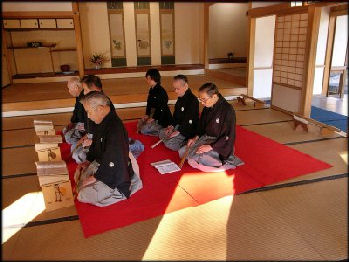
Chanting monks in Japan And when he has enjoyed that celestial delight, and completed his lifespan there,
The wise man, deceased front the Deva-world, becomes a man of wealth.
In hundreds of thousands of Nayutas of Kotis of births he will everywhere
Be honored after he has placed a garland on a shrine.
When he has given but a strip of cloth to the Saviour of the world, to the Protector,
All his aims will prosper, both among Gods and among men.
He keeps out of the inferior and unlucky modes of life, and is -not reborn in them.
When he has made a bower of garlands over the relics of the Saviour of the world,
He becomes a powerful king with a loyal retinue.
He is dear and cherished, honourcd and praised,
By Gods and Nagas, and the wise -men in this world.
Wherever that hero is born, glorious with his merit's glory,
There his family is honoured, his country and his town.
Listen to me telling you of his advantages if he takes a speck of incense finer than a mustard seed '
And burns it at the shrines of the Lord: Serene in heart he forsakes all obstructions and all taints;
In whichever region he is, there he is full of merit, altogether full of health, firm in his intelligence, and alert,
He averts sorrow, and he goes his way dear and pleasant to many people.
if he should gain a kingdom, he honours the supreme Jina, a wise universal monarch of great might,
Golden his colour, adorned with marks, his body emits a pleasant odour in all worlds.
At birth already he receives the best of clothes, silken garments,
heavenly, superb, well made.
He is blessed with a beautiful body when he has clothed the Saviour's shrines with robes.
it is because he has done worship with robes at the shrines of the unequalled Saviours,
That here in this world his body becomes unequalled, and armoured with the thirty-two marks.
Buddhist Temple Customs and Activities
Temples are places where people pray, meditate participate in religious ceremonies, make offerings, light incense and candles, offer food to monks, meditate alone or in groups, chant mantras, listen to monks chant mantras, attend lectures or discussions led by respected teachers . Individual may also seek counseling from monks on nuns on personal matters. Buddhists are not required to visit temples.
Always walk clockwise around Buddhist monuments, keeping the religious landmarks to your right. The Buddhist practice of circling stupas and religion sites is believed to have been derived from cults that circled solar temples.
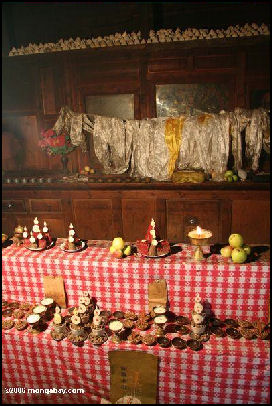
Temple offerings in Tibet People are supposed to take off their shoes before entering a temple. Some cultures require visitors to take their shoes when entering the temple grounds. Others only require that they be removed when entering a shrine or pagoda. Some people wash their feet before entering a temple. Shoes get the temple dirty and desecrate it. This custom may be rooted in the belief, particularly common in Southeast Asia, that the head is the highest and most virtuous part of the body and the feet are the lowest, dirtiest and most despicable part.
People should have their arms and legs covered when they enter a temple. It is generally okay to wear pants. Wearing improper attire — such as men with no shirts or women in short skirts — in a religious shrine is also considered disrespectful. Hats should also be removed. In places with lots of tourists, short pants are tolerated. Don’t take photos during prayers and meditation. When taking a picture of a Buddhist monk, ask their permission first. As a rule don’t take photos without permission and don’t use a flash.
There are rules that people who have ingested alcohol or garlic are not allowed in temples because such things are said to disturb the human mind. Some temples however allow smoking because Buddhism does not directly ban smoking. In Japan there are temples with no smoking areas, Although smoking is not banned the temples hope that smokers will voluntarily refrain from lighting up.
Buddhist Offerings
Offerings are objects set on altar tables before images of The Buddha and Buddhist deities at temples or at home. Among the items presented as offerings are special flowers, lotus blossoms, rice balls, fruit, sweets, amulets, coins, business cards, lotus buds, holy water, tea, candles, and incense.
In Theravada Buddhism worship and devotion to persons is frowned upon. The offerings of fruit, incense and flowers are symbols of impermanence not an object of worship. Flowers wilt, food decays and candles, lamps and incense go out. Buddhists believe the soul of the offering is taken, not the offering itself. Food offerings are sometimes eaten after they are presented and flowers are sometimes ground up and used as fertilizer. The leaving of offerings as tributes to deities and Bodhisattvas is more acceptable among Mahayana Buddhists.
Worshipers at temples often visit different altars, make offering of lotus buds or flowers and leaving burning incense and candles at each one. Some people pray by bringing their clasped hands to their foreheads and then place three incense sticks at the altar. Others bow at the altar and sprinkle water, a symbol of life. Others still, kowtow before shrines, by bending down and stretching three times, or by prostrating themselves.
Votive offerings are usually made in the shape of the things that people want. A model of a breast is presented for a large supply of mother's milk. A laydels are offered by women who want to bear a child; if the lodale has a hole in it that means the mother wants an abortion. Figures offered are usually eyeless until the prayer is answered. Prayers are also said before bone reliquaries.
Many Buddhist homes and business run by Buddhists (in Thailand, even brothels) contain an altar of some sort. The altar usually features images of Buddha, Bodhisattvas, devas, photographs of family members and famous monks as well as offerings of flowers, candles, incense lotus blossoms, rice balls, incense, fruit, sweets and amulets.
Chinese Buddhist Temples Activities and Acts of Worship
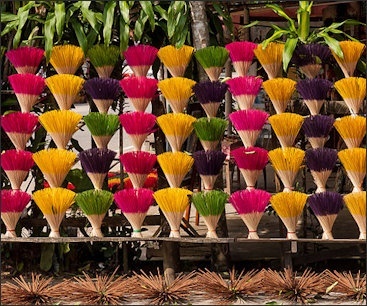
ncense sticks for sale in Vietnam
Patricia Buckley Ebrey of the University of Washington wrote: “Common forms of Buddhist practice for lay persons include visiting temples to pray, burn incense, place offerings of fruit or flowers at altars, and observe rituals performed by monks, such as the consecration of new images or the celebration of a Buddhist festival. Buddhist women's association meet for worship. Ceremonies at tenmples are held for things like the enshrinement of an image of a wealthy patron. [Source: Patricia Buckley Ebrey, University of Washington, depts.washington.edu/chinaciv /=]
Joss sticks (incense sticks) have traditionally been an important component of Taoist religious practice. Worshippers believe the smoke helps waft prayers towards their deities. Today the sticks are also fixtures of Confucian and Buddhist worship. Sometimes they are even part of Christian rituals. Worshippers normally light three joss sticks in the courtyard of the house of worship, and place them in sand-filled containers or in specially prepared racks. [Source: The Religions of South Vietnam in Faith and Fact, US Navy, Bureau of Naval Personnel, Chaplains Division,1967 ++]
Joss sticks and incense burners are found in family altars, spirit houses, and temple courtyards and before the figures of Buddha. Not all joss sticks are fragrant as some are primarily for smoke and have only the faintest odor. However, the more favored joss sticks are the ones with incense which serves both as a means of veneration and as a practical deodorizer. Few homes are without a joss stick to be utilized for some reason. Traditionally, joss sticks have been handmade. Basically the joss stick is made with a thin bamboo stick, which is painted red, Part of the stick is rolled in a putty-like substance-the exact formulae are guarded by their owners. ++
Joss sticks are very reasonably priced, and it is good for the common people that this is so, for few acts of devotion could be complete without the lighting of joss sticks. These may be placed in sand-filled containers either in the temple courtyard or in racks located in front or on top of an altar. Sometimes after burning joss sticks are placed in front of a Buddha statue, the ascending smoke from the burning joss stick is thought by some to have beneficial aid in pleasing that power to whom worship is made, or prayers offered. ++
Temple Rituals and Etiquette in Japan
Temples are places where people pray, meditate participate in religious ceremonies, make offerings, light incense and candles, offer food to monks, meditate alone or in groups, chant mantras, listen to monks chant mantras, attend lectures or discussions led by respected teachers . Individual may also seek counseling from monks on nuns on personal matters. Buddhists are not required to visit temples.
One needs to take one's shoes off only if entering a temple. Hats should also be removed. Do not clap at Buddhist temples as you would at a Shinto shrine.

12th century Japanese Buddhist flower basket
Praying is done by prostrating oneself or bowing with hands clasped from a standing or seated position in front of an image of Buddha. Prayers are usually made after tossing a coin into the saisen-bako (offering box). Offerings left at shrines include coins, apples, business cards,
Many Japanese visiting temples and shrines attach omiyuki folded paper fortunes to trees in the belief it will bring them good fortune. At some Buddhist temples visitors pay ¥300 for the privilege of writing the prayers on wooden rice spatulas.
Tibetan Buddhist Religious Objects
The thunderbolt (dorje or vajra) and bell (drilbu) are ritual objects used in Tantric rites that symbolize male and female aspects. The male thunderbolt is a double-headed object held in the right hand. Associated with skill and compassion, it is regarded as indestructible and has the power to cut through ignorance. The bell is held in the left hand. It represents wisdom, emptiness and nirvana.
The ritual dagger (phurbu) is used in Tantric rituals to “drive the invocation on it way.” Based on a design used by Guru Rinpoche to nail down evil spirits, it has three sides which cut through the core of passion, ignorance and aggression.
Tibetans use cups and bowls made of human skulls and flutes carved out of human thigh bones. Some ceremonies at Portala Palace in Lhasa incorporate hourglass-shaped drums fashioned from two skulls, and a container made from a silver-encrusted upside-down skull (the jaw bone serves as the container's lid). Skull drums are usually covered by leather. Sometimes they are covered with human skin. The bones belong to revered lamas and monks.
Tibetan Buddhists also use rosaries made of beads from 108 different skulls. Objects made with human bones are not regarded as gruesome but rather as symbols of the shortness of life and need for religion to facilitate rebirth. Each time the beads are touched, a prayer is said and merit is earned.
Mani stones are flat-surfaced stones carved by Buddhist devotees to earn merit. Most are inscribed with prayer "om mani padme hum" ("Hail to the Jewel in the Lotus"). They are often placed alongside trails near Tibetan-style monasteries and temples. In some places you can find prayer walls, hundreds of meters long. composed of mani stones. Travelers should always pass these walls on the left and consequently most prayer walls have trails on both sides.
See Separate Articls: TIBETAN BUDDHIST OBJECTS: MANI STONES, PRAYER WHEELS AND HUMAN BONES factsanddetails.com TIBETAN BUDDHIST RITUALS, CUSTOMS AND PRAYERS factsanddetails.com
Release of Caged Birds
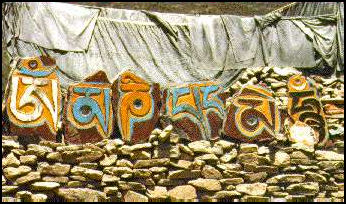
Mani stones Sometimes, outside Theravada Buddhist temples, young children and other people with caged songbirds offer visitors the chance to set them free. For a small amount of money, children will open the cages and release the birds which is said to bring luck and blessings in this life and earn the liberator merit which can be used towards one’s next reincarnation. The birds are usually sparrows or finches. Many of the birds are caught again after they are released.
Reporting from Phnom Penh, Alan Sipress wrote in the Washington Post, “Over the centuries, Buddhists in Cambodia and elsewhere in Asia have released the sorrows born of sickness, hunger and war through the simple, cathartic act of buying caged birds and setting them free, sometimes with a kiss. In front of the shimmering gold pagoda of Wat Phnom, built on the grassy hill that lent the capital its name, Cambodians reach inside the metal and wire mesh cages, draw out sparrows, swallows, munias and weavers, often in pairs, then raise them in cupped palms to their lips. The devotees mumble a prayer and then set them free into the warm, still air. [Source: Alan Sipress, Washington Post, March 16, 2006 ||||] “On a recent morning, Kong Phalla, a young, slight woman wearing a red knit cap, stood under a tree at the base of Wat Phnom, clasping lotus stems in one hand and a metal cage crammed with scores of birds in the other. She said that the birds had been shipped into the city overnight by boat and that she had sold nearly three dozen to worshipers by the morning. "They want to free their depression, free their sadness and illness with the birds," Kong Phalla, 23, explained, resting the cage beside a table of incense sticks.
“She flashed a thin smile, saying she had brought five cages to the temple and was confident that nearly all 1,000 birds would be gone by nightfall. Bird flu was of no concern, she continued, patting the cage. It is only the foreign tourists who fret, often paying her to release the birds herself so they do not have to touch them. Spotting a Cambodian man approaching the temple, she abandoned her thought and gave chase, following him up the long brick staircase, past the statues of lions and balustrades of mythical serpents, beseeching him at each step to purchase a few of her birds. ||||
“At another pagoda in the Cambodian capital, Khy Sovanratana sat cross-legged on a thin cushion, his orange monk's robe draped over his left shoulder. He recounted the legend of how the Buddha, before attaining enlightenment, had found a swan wounded by an arrow, nursed the creature back to health then set it free. "Giving life is very much extolled in Buddhism," the monk explained softly. "People here hope that by releasing a bird, they will give life to another being, and they will also be free from illness, trauma and depression." ||||
Moreover, the monk continued, the act of liberating a living creature can also earn devotees religious merit toward reincarnation into a better life. But, setting aside the sublime, he added: "There's no point if you don't get benefits but instead catch a virus. Monks should be given this kind of awareness and pass it on to devotees when preaching." ||||
“Though the ritual of releasing birds is practiced in several Asian countries with Buddhist populations, the tradition in Cambodia is intertwined not only with religion but national identity. The king frees doves, pigeons and other wild fowl about four times a month — in especially generous numbers to mark royal birthdays — and this has complicated efforts to curb the practice. Its adherents rarely remark on the apparent contradiction of trapping birds only to set them free — an irony compounded by the attempts of some boys to catch fowl moments after their release so they can be sold yet again. |||| “Not long after Kong Phalla vanished up the steps of Wat Phnom, a Cambodian family approached another, smaller shrine along the city's Tonle Sap River across from the ornate royal palace. The family briefly haggled with a peddler, then purchased an entire cage of birds, about a hundred of them with frenetic, flapping wings. Two by two, the family pulled the birds from behind the mesh and, with the occasional whisper of a prayer, set them loose until all of them had disappeared along the banks.” ||||
Bird Flu and Animal Rights Puts a Damper on the Release of Caged Birds

woman in Myanmar offering birds to release
In the mid-2000s, bird flu added an element of danger to the practice of releasing caged bird. Alan Sipress wrote in the Washington Post, “Animal health experts warn that the practice of capturing wild birds, holding them in confined quarters and then turning them over to human hands could spread avian flu among birds, across species and on to people. So far, avian influenza has not been diagnosed in any of the birds released at the temples of Buddhist Asia, from Thailand to Taiwan. But that is only because so few have been tested, according to Martin Gilbert, a field veterinarian with the U.S.-based Wildlife Conservation Society. The virus, which has killed people in at least seven countries, including Cambodia, and infected birds on three continents, has been discovered in some of the same species that are sold in front of Buddhist shrines. [Source: Alan Sipress, Washington Post, March 16, 2006 ||||]
“Gilbert said that the threat is comparable to the danger posed by live poultry markets blamed for several Asian outbreaks of the highly lethal H5N1 strain of bird flu, including one in Phnom Penh this month. "H5N1 is out there and we have to be cognizant of the risks in acting this way," Gilbert cautioned. Gilbert's team has run into resistance from peddlers when trying to take fecal swabs from the birds to test for the disease. So in recent weeks, he enlisted a former Cambodian monk, a young man who swapped the monastery for work as a wildlife researcher, to delicately negotiate with the sellers. ||||
“Another U.S.-based group, WildAid, previously tried to curtail the practice of selling birds for the tradition on the grounds that the exchange represented improper trade in wildlife. The group established a rapid-response unit that included Cambodian military police and forestry officials and carried out several raids on bird peddlers. The campaign culminated last June in the confiscation of birds sold at Wat Phnom and elsewhere, according to Nick Marx, who coordinated the effort. But because of religious and political sensitivities, the government postponed further raids. "We were requested at least temporarily to stop doing this until the government decides what to do about the matter," Marx said. "It's a difficult issue."
"I have no concern about getting sick with bird flu, and the buyers have no concern," said Srey Leap, a 21-year-old bird merchant, who watched from the shade of a nearby umbrella. "They never worry about this. It is our Cambodian tradition."..."Bird flu has never happened to me," Kong Phalla boasted reassuringly.
Buddhist Monks Set 600 Pounds of Lobsters Free in the Ocean

Birds are not the only animals released by Buddhists to win merit. Sometimes they release fish or other sea creatures. In 2016, the Daily Meal reported: “Summertime is prime lobster roll season, but this week more than 600 pounds of lobsters were rescued from the pot by some generous monks in Canada, who bought them with the specific intent of releasing them back into the ocean. [Source: The Daily Meal, Fox News, July 12, 2016 ^]
“According to CBC News, the Buddhist monks were from Canada’s Prince Edward Island, and they bought dozens of live lobsters from various sellers around the island. On Saturday, the monks boarded a fishing boat and released the live seafood back into the ocean off the coast of Wood Islands. "Hopefully, we can find a spot where there are no cages waiting for them," said one monk from the Great Enlightenment Buddhist Institute Society. ^
:Before releasing the lobsters, the monks held a 20-minute ceremony with a prayer and chant to Buddha. One of the monks told reporters that they were not freeing the lobsters to promote vegetarianism or veganism, but just to cultivate compassion towards living things. The monks said they had the support of local fishermen, who even advised them on where they could release the lobsters so they wouldn't wind up back in traps again. One monk says he hopes their act will inspire others to pay-it-forward to others living creatures. "This whole purpose for us is to cultivate this compassion toward others. It doesn't have to be lobsters, it can be worms, flies, any animals, drive slower so we don't run over little critters on the street."” ^
Snake Release Results in the Killing of Hundreds of Snakes
In 2016, a woman in China has released hundreds of snakes into the wild as part of a ritual which shows compassion to all creatures. The result was that villagers slaughtered hundreds of snakes fearing they would be bitten by venomous ones. "Originally we gave salvation to more than 200 snakes, but we estimate that now there are over 900!" said the woman, who calls herself "Cool Mandy" on the Chinese microblogging platform Weibo. [Source: BBC, June 10, 2016]
According to the BBC: “The snakes were reportedly set free in a mountainous area in southwestern Sichuan province and quickly slithered their way to nearby a village. In the ensuing upheaval, its fearful residents caught and clubbed the vermin to death by the dozen, the Shanghaiist website reports. "Villagers said that they have had a few restless nights in the last week," it reports. "For instance, one anxious villager surnamed Lei couldn't help but circle around his house once every hour to make sure it was clear of snakes."
“The villagers' fears appear to be well-founded. The Chengdu Economic Daily, a local newspaper, reports that at least some of the serpents have been identified as venomous. Releasing captured wildlife is considered a righteous deed that brings good karma in China, says Yashan Zhao from BBC Chinese. The ritual is particularly popular among Buddhists, and normally involves purchasing fish, frogs, birds, turtles, etc. at local markets before releasing them into the wild. But "Cool Mandy's" stint earned her few karma points among Chinese bloggers. "I condemn this releaser, she should be punished, she has created a dangerous situation for the villagers" is a popular view, and one Weibo user wonders: "Why didn't she just release them in her own bedroom?"
Image Sources: Wikimedia Commons, Mongabey, Ray Kinnane, Brooklyn University, Buddhist door (birds) and Buddhist channel (birds)
Text Sources: East Asia History Sourcebook sourcebooks.fordham.edu , “Topics in Japanese Cultural History” by Gregory Smits, Penn State University figal-sensei.org, Asia for Educators, Columbia University; Asia Society Museum “The Essence of Buddhism” Edited by E. Haldeman-Julius, 1922, Project Gutenberg, Virtual Library Sri Lanka; “World Religions” edited by Geoffrey Parrinder (Facts on File Publications, New York); “Encyclopedia of the World's Religions” edited by R.C. Zaehner (Barnes & Noble Books, 1959); “Encyclopedia of the World Cultures: Volume 5 East and Southeast Asia” edited by Paul Hockings (G.K. Hall & Company, New York, 1993); BBC, Wikipedia, National Geographic, New York Times, Washington Post, Los Angeles Times, Smithsonian magazine, The New Yorker, Reuters, AP, AFP, and various books and other publications.
Last updated March 2024
